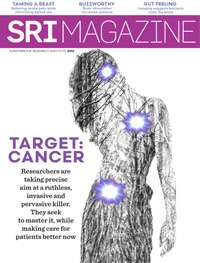Optimizing rehab for stroke patients

New therapeutic technique called CO-OP strives to have more meaningful impact on skills
People living with the effects of a stroke face a challenging road to recovery. Evidence suggests treatments that incorporate task-specific training are effective in helping to improve walking and upper-arm and hand function. An approach called CO-OP, which stands for cognitive orientation to daily occupational performance, teaches patients to use cognitive strategies in addition to task-specific training. Adding these cognitive problem-solving techniques might help people to learn better and retain important skills. There is not a lot of research, however, that has evaluated this new concept.
Dr. Sara McEwen is a scientist in the St. John’s Rehab Research Program at Sunnybrook Research Institute with a background in physiotherapy. She led a randomized controlled trial that compared the CO-OP approach with typical rehabilitation that aims to help patients improve function in everyday living. Participants who had a stroke less than three months before the study received outpatient rehabilitation at St. John’s Rehab in Toronto and The Rehabilitation Institute of St. Louis in Missouri, U.S.

Getting dressed independently is an example of a personal goal participants aimed to achieve during the study.
Photo: iStock.com / lisafx
“CO-OP is a problem-solving approach that focuses on actual performance of meaningful activity, and we use something called ‘guided discovery’ as our main therapeutic technique,” says McEwen. The approach was originally designed for children with a motor learning disability, but McEwen adapted it for adult stroke patients. “There are few direct instructions. We coach patients and ask questions. We also teach them a problem-solving framework that is: goal, plan, do, check, [which] they use to learn every activity.”
Participants each established five personal goals that were specific to them. Examples included getting dressed independently, washing the dishes, throwing a football and playing the drums. In the CO-OP group, three goals were specifically trained and two were untrained tasks that the therapists did not work on with the patients. In the usual care control group, the therapists determined how many of the goals were trained or not.
A video-recorded performance test rated the quality of tasks completed. McEwen found the CO-OP group improved about three times as much on performing trained goals compared with the control group, and twice as much on untrained goals. The study suggests the CO-OP approach not only enhanced performance on skills trained during therapy, but also helped patients transfer skills such that they were able to learn additional activities outside of the rehab setting. Results were published in Neurorehabilitation and Neural Repair in 2015.
McEwen co-authored another study using the same trial participants that was published in The American Journal of Occupational Therapy. Researchers compared CO-OP with standard therapy on upper-arm and hand movement, cognitive ability and the effect of stroke on health-related quality of life.
“This study showed early evidence that CO-OP is associated with a moderate effect compared to usual care on aspects of cognition, and arm and hand function in stroke patients, even though we did not train those components,” says McEwen. “This is a really big deal because generally rehab therapies work specifically on the thing we train, but don’t generalize well to other impairments and activities.”
McEwen is collaborating with Elizabeth Linkewich, who is the director of the Regional Stroke Centre and the North & East GTA Stroke Network. They are studying how CO-OP can be implemented at five in-patient rehabilitation sites across Toronto, including St. John’s Rehab.
“We are teaching people to do what’s meaningful to them. We’re giving them the tools to transfer and generalize that learning to their home and community environment,” says McEwen.
— Eleni Kanavas
McEwen’s research is funded by the Canadian Institutes of Health Research.


 Spotted: Imaging and the injured brain: detecting the obvious and the insidious
Spotted: Imaging and the injured brain: detecting the obvious and the insidious Brain stimulation plus rehab equals better mobility after a stroke: Gentle electric current applied through the head helps patients regain some function
Brain stimulation plus rehab equals better mobility after a stroke: Gentle electric current applied through the head helps patients regain some function
